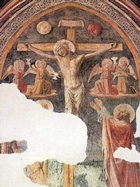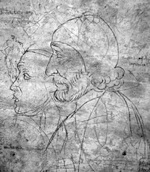
Sketch by Nicolò di Liberatore, in Casa del Nicolò di Liberatore
The nearby inscription reveals that it depicts the artist and his wife
Nicolò di Liberatore was born in Foligno and trained in the workshop of he father-in-law, Pietro di Giovanni Mazzaforte. [Link to Casa del Nicolò di Liberatore]
In 1458, Ugolino di Gisberto signed a contract for a year-long position as a “garzone” (apprentice) in the workshop of Pietro di Giovanni Mazzaforte and Nicolò di Liberatore, l’Alunno.
His earliest surviving signed panel, dated 1457, the Virgin and Child Enthroned with saints belonged had been the central panel of a polyptych commissioned for San Francesco, Deruta, which is now in the Pinacoteca Comunale there (search on “Pinacoteca”). He was commissioned with Pietro di Giovanni Mazzaforte to execute a polyptych (1465) for San Francesco, Cagli that bears only his name (now in the Brera, Milan). Other dated works by Niccolò di Liberatore outside Umbria include:
-
✴a polyptych (1466) for Sant’ Angelo, Montelpare (now in the Pinacoteca Vaticana, Rome); and
-
✴a triptych (1468) now in the Pinacoteca Civica Pietro Tacchi Venturi, San Severino
One of the predella panels of the San Nicolò Polyptych (1492 - see below) contains the inscription that referred to “Nicholaus Alunnus Fulginiae” (Nicholas, alumnus of Foligno), which led Giorgio Vasari to coin the nickname l’ Alunno.
After 1480 Nicolò di Liberatore executed works with his son Lattanzio di Nicolò (active 1480–1527). After his death, Lattanzio completed the Martyrdom of St Bartholomew (1502-3) for San Bartolomeo di Marano, Foligno (see below).
Foligno
St Sebastian (15th century)
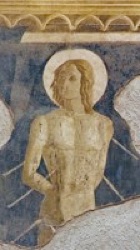
Frescoes (1456–8)
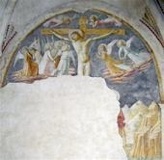

These frescoes were commissioned from the young Nicolò di Liberatore (among others) in ca. 1456. According to the historian Ludovico Jacobilli, the fresco of the Crucifixion on the back wall of the Cappella di Santa Marta, Santa Maria in Campis was signed by Nicolò di Liberatore and dated 1458. Any such signature has since disappeared but the attribution is confirmed on stylistic grounds. The fresco was damaged when a door was inserted in the back wall in 1515.
The chapel was closed in the 17th century and subsequently forgotten until the frescoes were rediscovered in 1901. The campanile was finally demolished in 1949 to facilitate the restoration of the chapel and its frescoes. A fragment of the head of St John the Evangelist,which came from this fresco, is now in the Museo Diocesano.

-
✴the Annunciation and two scenes from the life of St Thomas on the left wall (illustrated here);
-
✴other scenes from the life of St Thomas on the right wall; and
-
✴standing figures of the Madonna and Child and SS Catherine, Lucy and Benedict in the entrance arch.
Virgin and St John the Evangelist (ca. 1463)
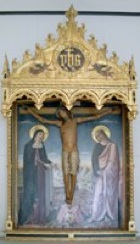
The confraternity took the tabernacle with them in 1569 when they moved to the Oratorio della Misericordia. It was moved to the sacristy of the Duomo in 1904 and is now in the Museo Diocesano.
San Nicolò Polyptych (1492)
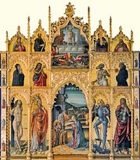
The polyptych bears the signature “Nicholaus Alunnus Fulginiae” (Nicholas, alumnus of Foligno), which famously led Giorgio Vasari to coin the nickname l’ Alunno. It is now in the Cappella di San Giuseppe at the centre of the right wall.
-
✴The central panel depicts the Nativity, with SS Sebastian and Nicholas of Bari on the left and SS Michael and John the Evangelist on the right.
-
✴The upper register depicts half-length figures of:
-
•SS Monica and John the Baptist on the left; and
-
•the Blessed Peter Crisci and St Nicholas of Tolentino on the right.
-
✴The cusp depicts the Resurrection and the doctors of the church.
Dominique-Vivant Denon selected the altarpiece for confiscation after the Napoleonic suppression of 1810, and it was duly sent to Paris. Antonio Canova recovered most of the panels in 1817, and they were returned to San Nicolò.
However, the predella panels, which depict stories of the Passion, were left behind. They are now in the Louvre, Paris and are illustrated in the museum's website.
Coronation of the Virgin with saints (1495)
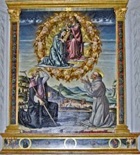
The coronation takes place in a mandorla of angels. Kneeling figures of SS Antony Abbot and Bernardino of Siena witness the scene. St George can be seen killing the dragon in the background.
The predella contains tondi of the Pietà, the Virgin and St John the Evangelist.
Stigmatisation of St Francis (15th century)
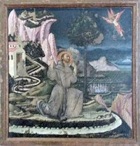
Martyrdom of St Bartholomew (1502-3)
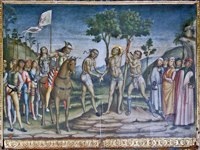
This altarpiece in San Bartolomeo di Marano was commissioned from Nicolò di Liberatore. A codicil to his will in 1502 records that it was "non ancora perfettamente compiuto" (not yet perfectly complete), and obliged Lattanzio di Nicolò to complete it using materials in their workshop. It depicts St Bartholomew tied to two trees while soldiers flay him alive.
Frescoes (15th century)
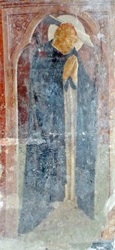

Two frescoes in Santa Maria Infraportas are attributed to l’ Alunno:
-
✴St Peter Martyr (under the 2nd arch on the right); and
-
✴Christ carrying the cross (under the 1starch on the right).
Works in the Pinacoteca Civica
The Pinacoteca Civica containsthree works that are attributed to Nicolò di Liberatore:
Annunciation (15th century)
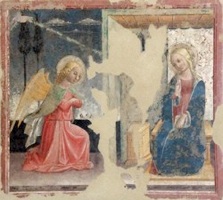
This fresco from a house in Via Piermarini is attributed to
two panels (15th century) that belong to the Cassa di Risparmio di Foligno
tiny panel of the Madonna and Child in an ornate frame; and
dark panel of the Pietà with angels .
Assisi
San Rufino Polyptych (1462)

Giovanna, the widow of Francesco Acceptanti, left money in her will for this polyptych for San Rufino in 1462. The inscription on the base of the throne contains the signature of Nicolò di Liberatore and a date (MCCCCL ...). Giorgio Vasari saw the altarpiece on the high altar of San Rufino in 1563, but it was removed during the remodelling of the choir, which began in 1575. It was first recorded on the Altare della Immacolata Concezione (the 3rd on the left) in 1581 and it remained there until 1864. It is now in the Museo Diocesano.
The main panels depict:
-
✴the Madonna and Child with angels and virgin saints;
-
✴a deacon and a bishop (presumably St Rufinus) on the left; and
-
✴St John the Evangelist and a deacon on the right.
The upper panels, were removed in 1672, when the chapel received its stucco decoration’ depict:
-
✴St Michael (in the pinnacle);
-
✴God the Father; and
-
✴figures of the Annunciation (to the sides).
The surviving predella panels (which are usually attributed to an assistant) depict:
-
✴the burning of St Rufinus and the discovery of his body in the River Chiascio (on the left); and
-
✴the translation of the relics to Assisi. In this last panel, an ox-drawn cart carries the uncorrupted body of the saint, with the earliest surviving cityscape of Assisi in the background.
The central predella panel, which was probably removed when a tabernacle was placed on the altar in 1582, was subsequently lost. The inscription that replaced it records that its surviving components were reassembled and restored in 1874.
Processional Banner (ca. 1462)
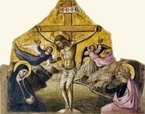
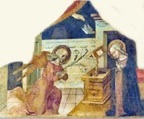
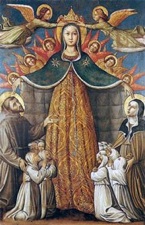
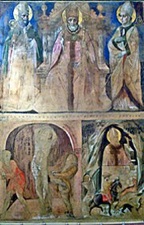
The two sides of this banner from the Oratorio di San Crispino have been transferred onto separate canvases and are now in the Pinacoteca Comunale:
-
✴The main panel depicts the Madonna della Misericordia crowned by angels, with St Francis commending the sisters and St Clare the brothers of the confraternity.
-
✴Its reverse depicts St Blaise enthroned with SS Rufinus and Victorinus, above two scenes from the life of St Blaise:
-
•his flagellation (on the left); and
-
•his help to a pagan knight fleeing from persecution, whom he hid in his grotto.
This part of the banner was first documented in the oratory in 1859, when it served as an altarpiece: the second side was turned to the wall, which probably explains its poor state of preservation.
In 1912, the scholar Umberto Gnoli recognised a banner in the Musée des Beaux Arts, Angoulême as a twin of this banner in Assisi. It had been first documented in 1858 in the collection of the disgraced Roman, Giovanni Pietro Campana. This collection had been sold to the French government in 1863. The banner moved from Angoulême to the Musée du Petit Palais, Avignon in 1974.
The history of these banners probably goes back to 1462, when Giacomo di Bartoluccio left money in his will for a processional banner for the oratory. This presumably provided the funds for at least one of them. Each has been attributed to Nicolò di Liberatore or his workshop throughout its documented history: most scholars hold that the banner in Assisi was a workshop copy of the one in Avignon, but some hold that the reverse is the case.
A double-sided panel in the Pinacoteca Comunale, Assisi, which depicts:
-
✴the Crucifixion with the Virgin and St John the Evangelist; and
-
✴the Annunciation,
can be associated with the banner there, albeit that it had been separated from the main panel by 1859: only the side depicting the Crucifixion was visible at that time, when it served as the upper part of the altarpiece on the main altar. The reconstruction illustrated above is based on the iconography of the banner in Avignon, which had passed into the Campanna collection in its entirety.
Granting of the Portiuncula Indulgence (ca. 1492)
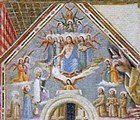
Fr Bernardino da Feltre, who had stayed at the Portiuncula in 1492, argued unsuccessfully that the bequest should be diverted to other uses. He argued that the earlier fresco on the facade should be preserved because St Francis himself had commissioned it, which suggests that it dated to the 13th century. He urged that the friars should confine themselves to retouching the inscription over the portal: “HAEC EST PORTA VITA AETERNAE” (this is the door to eternal life).
It seems that this inscription was repeated in the new fresco. Christ is depicted above it acceding to the request of the Virgin that those entering the chapel (at least on the appropriate feast day) should achieve salvation:
-
✴St Clare and a Franciscan bishop saint (either St Louis of Toulouse or St Bonaventure) kneel on the left, behind the Virgin;
-
✴SS Francis and two other Franciscan saints kneel to the right; and
-
✴a throng of angels surrounds the throne of Christ.
From Assisi
Processional Banner (ca. 1462)
This double-sided processional banner from the Oratorio di San Crispino, which is attributed to Nicolò di Liberatore, is now in the Musée du Petit Palais, Avignon. For details, see the description above of its twin in the Pinacoteca Comunale, Assisi.
Processional Banner (1468)
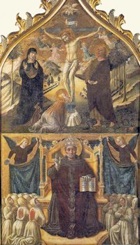
-
✴the Crucifixion with the Virgin and St John the Evangelist, with St Mary Magdalene at the foot of the cross, in the upper part of the composition; and
-
✴St Gregory the Great enthroned below.
Gonfalone della Peste (ca. 1470)
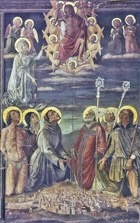
The chapel in the Lower Church had been acquired by two confraternities in 1535: the Confraternita di Santo Stefano and the Confraternita di San Gregorio. It seems likely that the banner had previously belonged to one of them. (The Confraternita di San Gregorio had owned another banner by Nicolò di Liberatore that is now in Karlsruhe - see above).
The banner from San Francesco was sold in the 19th century and is now in the Priesterhaus, Kevelaer (in northern Germany). It depicts:
-
✴Christ in majesty, in the upper part of the composition; and, below
-
✴SS Sebastian, Clare, Francis, Rufinus, Victorinus and Roch and (in the middle register) the Virgin, all of whom plead with Christ to spare the city from the plague.

The composition involves a fine cityscape of Assisi, which helps to date it:
-
✴it shows the Rocca Maggiore in the form that it took in 1460; but
-
✴it omits the scarp wall of the infirmary of the Sacro Convento, which was built in 1472.
Gualdo Tadino
San Francesco Polyptych (1471)

The main panels depict
-
✴the Madonna and Child enthroned with angels;
-
✴SS Paul and Peter on the left; and
-
✴SS Francis and Bernardino of Sienna on the right.
The other panels depict, from left to right:
-
✴in the upper register:
-
•St Christopher, with the baby Jesus;
-
•St Clare;
-
•Christ blessing;
-
•St Stephen; and
-
•St Julian;
-
✴in the lower register:
-
•St Secondus;
-
•St Antony of Padua;
-
•the Peità with the Virgin and St John the Evangelist;
-
•St Louis of Toulouse; and
-
•St Michael.
The standing figures in the side pilasters probably depict Apostles.
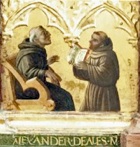
-
✴King Robert of Naples and Pope Alexander V, on the left;
-
✴Pope Nicholas IV and Cardinal Matthew of Acquasparta, on the right;
-
✴at the extreme, the delightfully short-sighted Fr Alexander of Hales, who reads from a book held for him by a young friar (illustrated here).
Nocera Umbra
Polyptych (1483)
This polyptych, which is signed and dated, was commissioned for the Duomo. It is now in the Pinacoteca Comunale.
[Describe]
Perugia
Gonfalon dell' Annunziata (1466)
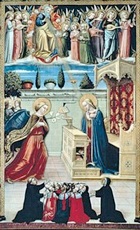
The Servites took the banner to Santa Maria Nuova when they moved there in 1540. It was first placed on the high altar there, and then moved to other locations in the church. It entered the Galleria Nazionale in 1863.
The central part of the banner depicts the Annunciation, set inside the palatial home of the Virgin. God the Father, who sits on a throne above that is formed by the wings of seraphim and surrounded by an angelic orchestra, sends the Holy Spirit towards the Virgin in the form of a dove. Below, SS Philip Benizi and Juliana Falconieri recommend a group of worshippers to the Virgin. (Neither had been canonised at the time that the banner was painted, and they are shown in their Servite habits with the rayonant haloes appropriate for the beatified.)
Prominent among the group of worshippers are members of the Collegio dei Dottori Legisti (the college of doctors of law): they are known to have walked in procession to the Servite church on the Feast of the Annunciation, and they were probably associated with the commission of the new banner. The group also includes members of the penitent confraternity, at least one Servite friar, and a group of pious women, most of whom wear Servite habits.
This panel seems to have inspired the composition of the panel of the Virgin Annunciate (1467-8) that is now also in the Galleria Nazionale, which is attributed to Bartolomeo Caporali.
Pietà with saints (early 16th century)
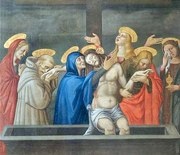
This panel, which now forms part of the Collection of the Fondazione Cassa di Risparmio di Perugia, is attributed to Nicolò di Liberatore and Lattanzio di Nicolò, and might be the Pietà from San Bartolomeo di Marano, Foligno that is mentioned in the will of the latter. It depicts the dead Christ on his sarcophagus with the Virgin and SS Francis, John the Evangelist and Mary Magdalen and two other female saints.
Spello
Frescoes in Cappella Tega (1461)
-
✴the Crucifixion with the Virgin and St John the Evangelists (illustrated here); and
-
✴the Evangelists (in the vaults).
Crucifixion (15th century)

Backdrop to a Crucifix (15th century)
An inventory made of the works of art in San Girolamo after its suppression in 1798 described a miraculous crucifix on the high altar that was taken in procession in times of adversity. There was a painted backdrop (presumably a panel) that depicted the grieving Virgin and SS Jerome; Francis; and John the Evangelist.
-
✴The inventory attributed the panel to “Onorio Nicolai di Foligno”: Giorgio Vasari had attributed it to Nicolò di Liberatore in the early edition of the “Lives of the Artists”. This panel subsequently disappeared.
-
✴The crucifix, which was still on the high altar when it was attributed to Giovanni Tedesco in 1994, was unfortunately stolen in 2004.
Spoleto
Triptych (15th century)
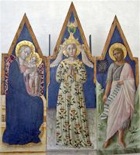
-
✴Santa Maria delle Grazie, which must have referred to the image of the Madonna and Child enthroned on the left;
-
✴Santa Maria dell’ Assunta, which must have referred to the image of the standing Virgin crowned by angels at the centre; and
-
✴St John the Baptist.
They are attributed on stylistic grounds to Nicolò di Liberatore. Scholars recognise a probable contribution by Ugolino di Gisberto, who was documented as an apprentice in the workshop of Nicolò di Liberatore in 1458.
The original location of the panels is unknown: they could have come from San Giuliano or from the earlier hermitage on the site of the Eremon di Santa Maria delle Grazie. They passed to the Congregazione di Carità in ca. 1860 and entered the Pinacoteca Comunale in 1921. They are now in Room 14 of the Museo del Ducato di Spoleto.
Terni
Crucifixion with SS Francis and Bernardino (1497)
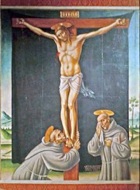
Todi
Predella panels (1491)

These panels formed the predella of a documented altarpiece from Santa Maria delle Grazie, Todi, which was sold in the 19th century. The main panel, which has been lost, apparently depicted a Pietà with the Virgin and St John the Evangelist. The Commune of Foligno bought the predella panels in 1950, and they are now in the Pinacoteca Civica, Foligno.
The surviving documentation includes a receipt signed by Nicolò di Liberatore in 1493, acknowledging payment by the Confraternita di Santa Maria delle Grazie for an altarpiece for their church. Nicolò wrote to the brothers in 1494, expressing his intention to return to Todi when it was “free from plague and other tribulations”. It seems that he never returned: in 1504, Lattanzio di Nicolò gave the brothers a receipt for 21 days’ work that he had done while his father was alive (i.e. before 1502), and a bill for subsequent work for the gilding of a tabernacle in the church.
The main panel of the predella depicts for prophets set against a landscape that is reminiscent of the plain of Foligno. The other two panels depict angels holding inscriptions:
-
✴that on the left includes includes the inscription "Nicolaus Fulginas pinxit: Lattantius filius i(n)auravit" (Nicholas painted it: his son, Lattanzio gilded it); and
-
✴that on the right gives the date 1491.
Read more:
E. Lunghi, “Niccolò Alunno in Umbria : Guida alle Opere di Niccolò di Liberatore detto l'Alunno nelle Chiese e nei Musei della Regione” (1993) Assisi
G. Benazzi and E. Lunghi (Eds), “Nicolaus Pictor : Nicolò di Liberatore detto l'Alunno: Artisti e Botteghe a Foligno nel Quattrocento” (2004) Foligno
Return to Art in: Assisi Foligno Gualdo Tadino Nocera Umbra


